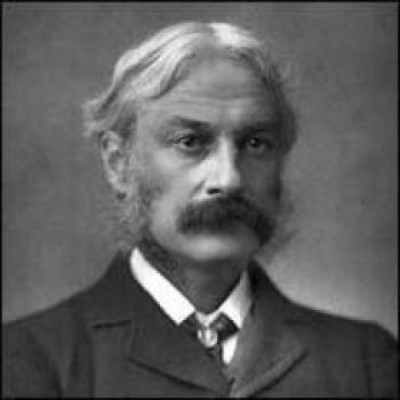“They are our oldest legacy, they will be our last bequest, flitting from mouth to mouth when the printing press is in ruins and the alphabet has to be re-invented.”

The gilt covers of the Fairy Books
Known as the “Kind Magician”, Andrew Lang is famous for his visually striking series of Fairy Books, twelve in total, written between 1889 and 1910. So bright were the gilt-embellished coloured covers that they stand out on a bookcase even today. These books revolutionized the reading habits of a whole generation of children. When the first was published fairy stories were generally disdained as tales for infants. Most of the retellings available at the time came from French sources: British children, it was thought, needed to develop into reading solid stories about real-life events and people, not exotic fables about fantasy figures.

Andrew Lang knew better. Growing up in Selkirk, in the Border Country, his imagination was alive with the ‘little people’ of local folklore, Shakespeare’s fairies and the ghosts of Walter Scott, a friend of his own grandfather. Nevertheless, it was his later academic studies that made the Fairy Book series more than a literary self-indulgence. He became convinced that fairy stories had an enduring appeal for all generations and an important role in culture as a whole. He saw children’s imaginations being reduced by the Victorian enthusiasm for industry, mechanization, materials, processes and things that really happened. Lang concluded that folk stories and fairy tales were in fact the foundation for higher forms of culture: far from being downgraded, derivative forms of it, they were a creative force that drove the development of more complex literary forms. Lang would also come to argue that fairy stories across the Eurasian continent were intimately connected, the same motifs rewoven and retold in constantly evolving forms.

Black and white illustration for the Goblin and the Grocer in the Pink Fairy Book
Even so, it was a surprise to Andrew Lang that the public played him at his own game. He expected to produce one or two books, not to edit an entire series. The Blue Fairy Book came out in 1889 at the beginning of what would become a long collaboration between Lang and his wife, Leonora, and also with Henry J. Ford, one of the book’s two illustrators. Ford would go on to illustrate all of the subsequent Fairy Books; Leonora was at the head of a team of writers gathering and recording the stories. Like the Blue Book, the Red and Green volumes that followed contained fairy tales known in Britain and Western Europe. Lang, however, lamented the large number that remained untold and his readers, hearing that the Green would be the last Fairy book, asked for more. Yellow, Pink, Grey, Violet, Crimson, Brown, Orange, Olive and Lilac followed in due order, geographically spreading outwards to include tales from Russia, Japan, Africa, Persia, India and South America. The first two books, Blue and Red, are the most scarce and sought after today. It is worth noting, however, that only the later volumes, from Violet onwards, contain the brightly coloured plates of Ford’s illustrations.

One of Henry J. Ford's illustrations from the Violet Fairy Book
Lang and his team were prolific, producing thirteen additional titles allied to the core series, among them Tales of Troy and Greece and The Red True Story Book. Lang found himself reminding readers over and over again that he had not generated the stories found in the Fairy Books. Yet because he appreciated how the fairy stories evolved, one from the other, with different motifs and figures woven together in varied ways, he tried his hand at writing his own tales, publishing them in My Own Fairy Book in 1896. Perhaps it would not have surprised him that neither these, nor the real-life stories of the True Story Books have surpassed the appeal of the original fairy tales he brought back to life for a society that so nearly laid them aside.
To browse through the Fairy Book titles in stock and other works by Andrew Lang, click here.
Recent Posts
- The Evolution of Crime
- Tour The Bookshop On Your Screen
- The Genesis of Mr. Toad: A Short Publication History of The Wind In The Willows
- Frank Hurley's 'South'
- The "Other" Florence Harrison
- Picturing Enid Blyton
- Advent Calendar of Illustration 2020
- Depicting Jeeves and Wooster
- Evelyn Waugh Reviews Nancy Mitford
- The Envelope Booklets of T.N. Foulis
- "To Die Like English Gentlemen"
- Kay Nielsen's Fantasy World
- A Brief Look at Woodcut Illustration
- The Wealth Of Nations by Adam Smith
- What Big Stories You Have: Brothers Grimm
- Shackleton's Antarctic Career
- Inspiring Errol Le Cain's Fantasy Artwork
- Charlie & The Great Glass Elevator
- Firsts London - An Audio Tour Of Our Booth
- Jessie M. King's Poetic Art, Books & Jewellery
Blog Archive
- January 2024 (1)
- January 2023 (1)
- August 2022 (1)
- January 2022 (1)
- February 2021 (1)
- January 2021 (1)
- December 2020 (1)
- August 2020 (1)
- July 2020 (2)
- March 2020 (3)
- February 2020 (2)
- October 2019 (2)
- July 2019 (2)
- May 2019 (1)
- April 2019 (1)
- March 2019 (2)
- February 2019 (1)
- December 2018 (1)
- November 2018 (1)
- October 2018 (2)